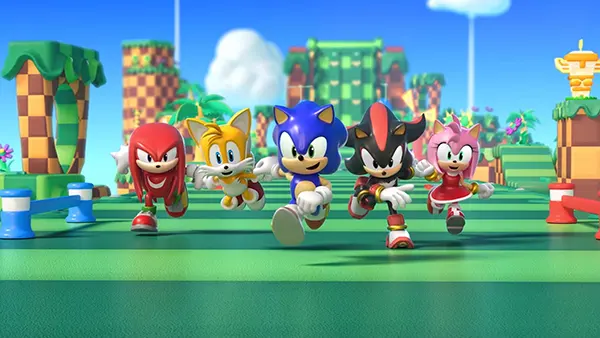
Review of Sonic Rumble: A Mobile Battle Royale with Iconic Sonic Characters
Sonic Rumble, set for a global release in May 2025, is a fresh and energetic mobile game bringing the iconic Sonic franchise into the world of battle royale. Developed by Sega and crafted specifically for smartphones, this title presents players with fast-paced, multiplayer action featuring beloved Sonic characters. The game capitalises on competitive instincts, nostalgic designs, and streamlined controls optimised for touch screens.
Gameplay Mechanics and Visual Style
Sonic Rumble places up to 32 players into a vibrant, obstacle-filled arena, where speed, timing, and clever tactics determine who remains standing. Matches are quick, typically under five minutes, making the game perfect for short sessions on the go. The core loop involves dodging hazards, jumping between platforms, and using character-specific abilities to gain an edge over rivals.
The art style stays true to the classic Sonic aesthetic, combining 3D chibi-style character models with detailed, dynamic environments. Each map draws inspiration from familiar Sonic zones, such as Green Hill or Chemical Plant, reimagined for multiplayer free-for-all chaos. The visual fidelity is impressive for a mobile game, with fluid animations and vivid colours maintaining an engaging atmosphere.
Character progression is integrated via costumes, unlockable skins, and power-ups. These do not grant competitive advantages but encourage player investment and personalisation. Monetisation is based on optional cosmetics, ensuring the game remains accessible without pay-to-win elements.
Controls and Accessibility
Sonic Rumble’s control scheme is intuitive and responsive, offering a joystick for movement and buttons for jumping or activating skills. The developers have ensured a low entry barrier for newcomers while providing enough depth for skilled players to shine. Gameplay is optimised for both portrait and landscape modes, with adaptive UI elements enhancing usability.
Accessibility features include customisable control layouts and adjustable visual settings to accommodate different devices and player preferences. Load times are minimal, and the game runs smoothly even on mid-range smartphones, thanks to performance-focused optimisation by the development team.
Cross-device compatibility allows players on both Android and iOS to compete seamlessly. An in-game tutorial introduces mechanics progressively, making the learning curve manageable without overwhelming users. The goal is to appeal to long-time Sonic fans and mobile gamers unfamiliar with the franchise alike.
Character Roster and Fan Service
The initial release of Sonic Rumble features an extensive cast drawn from the franchise’s rich history. Players can choose to play as Sonic, Tails, Knuckles, Amy, Shadow, and several lesser-known favourites like Cream or Rouge. Each character is equipped with unique animations and thematic cosmetics, enhancing their identity within the game.
Fan service plays a central role in design decisions. From classic sound effects to remixed music tracks, the game leverages nostalgia without sacrificing modernity. Seasonal events are planned post-launch, with time-limited character skins and community challenges designed to keep engagement high.
The storyline is minimal but features fun interactions between characters during matches and event cutscenes. While not essential to gameplay, these elements provide narrative flavour and reward fans familiar with the Sonic universe. Players can also form clans, complete daily objectives, and participate in ranking ladders.
Customisation and Progression
Progression in Sonic Rumble is cosmetic-driven. By earning or purchasing tokens, players unlock outfits, emotes, and themed effects for their chosen characters. These rewards are purely visual, preserving fair competition across all levels of play. The game avoids aggressive monetisation, with optional ads and purchases being non-intrusive.
A seasonal battle pass system encourages regular play through daily missions and weekly challenges. The pass includes free and premium tiers, allowing players to earn rewards regardless of payment. Progress is shared across accounts, meaning switching devices does not impact a player’s inventory or achievements.
Customisation also extends to player banners and victory poses. These elements contribute to a sense of individuality and ownership, incentivising return engagement. All upgrades and rewards are presented transparently, reinforcing the game’s commitment to trust and fairness.

Online Features and Competitive Play
Sonic Rumble includes robust online infrastructure, supporting fast matchmaking and minimal latency. Players can form parties, join ranked queues, or enter casual modes depending on preference. Global leaderboards and seasonal rankings provide competitive motivation, while friendly matches allow for stress-free fun.
Competitive play is balanced via skill-based matchmaking, ensuring new players are not immediately pitted against experienced ones. The game’s backend servers handle thousands of concurrent users with impressive stability, even during peak hours. Sega has confirmed ongoing technical support and server expansions post-launch.
Community features are integrated directly into the game. Players can chat with friends, send emojis during matches, and participate in time-limited tournaments. Future updates will include spectator modes and replay systems to support content creators and eSports-style tournaments.
Future Roadmap and Expectations
According to official announcements, Sega plans to introduce new characters, modes, and collaborations throughout 2025. The developers have committed to transparency with players, sharing patch notes and engaging with the community via forums and social media. Feedback loops are in place to ensure updates reflect player desires.
Crossovers with other Sega properties are expected, with datamined content suggesting appearances from characters outside the Sonic universe. These events aim to broaden the player base while maintaining the game’s identity. Regular quality-of-life improvements and bug fixes will be deployed based on telemetry and user reports.
In terms of longevity, Sonic Rumble appears well-positioned for ongoing success. Its blend of classic charm, modern gameplay, and fair monetisation has resonated positively with early testers. The coming months will determine its lasting appeal, but current indicators suggest a strong reception upon launch.
